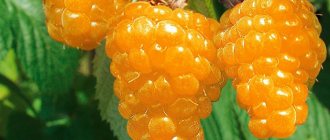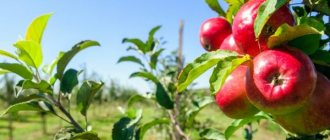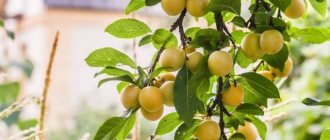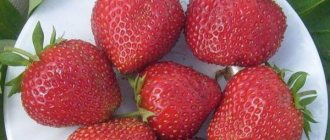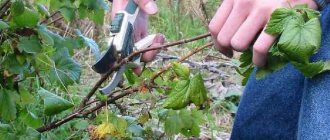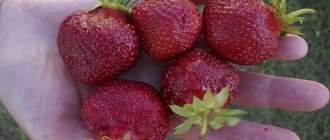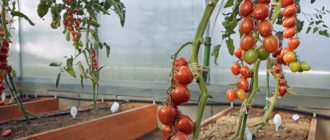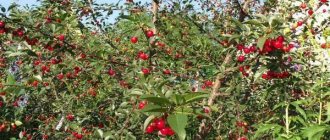Characteristics of the raspberry variety Vera
AGRO PREMIUM is an innovative, environmentally friendly plant activator, without chemicals, that protects berries, fruits and vegetables from pests and diseases, increases seed germination, stimulates root formation and plant growth, and significantly increases productivity.
The high-yielding crop was registered in 1989. As you can see, it appeared 30 years ago. This is the result of selection of varieties, and thanks to scientists from the Siberian Research Institute named after. M.A. Lisavenko. Three types of raspberries were used for selection.
These are the “parents”:
- Kaliningradskaya,
- Barnaulskaya,
- Kuzmin's news.
It was recommended to grow it as frost-resistant. The location has also been determined. These are the Volga-Vyatka, Central Black Earth, and West Siberian regions.
The yield has been achieved. Therefore, farmers are now happy to grow it for sale. As for frost resistance, they have doubts. Hybrids, even in the center of the country, often freeze to death. Therefore, it is impossible to do without solid shelters.
- The crop has a short growing season. This is an early ripening variety.
- Flowering shoots begin in mid-June. The first ten days of July is harvest time.
- Vera has medium-sized, semi-spreading stems with a height of 150-180 cm.
- The bushes are fully formed almost after three years after they are planted.
- Annual shoots are green in color, with slightly curved, flexible tips.
- In biennials, the stems are brown, elastic and flexible.
- Raspberry Vera with erect shoots, soft small thorns, with medium shoot formation. It reproduces easily, but without abundant growth near bushes.
- Thanks to its flexibility, when covered, the crop calmly bends to the ground.
- Plants with medium-sized, wrinkled, dark green leaves.
- Vera produces berries with a medium and small size of 1.8 -2. g, blunt-conical shape, uniform purple color, sweet and sour taste.
- Due to the fact that the drupes have poor adhesion to each other, the berries are difficult to transport and keep well.
- Simultaneous fruit ripening is observed.
- During the summer season, about 3 kg of berries are harvested from one plant. From one hectare - up to 13 centners.
- If the temperature is less than 25 degrees in a snowless winter, you definitely need to cover the raspberry tree.
- The culture does not like drought. She prefers rainy weather.
- Raspberries can get purple spot, but can withstand the attacks of the shoot gall midge.
- When picked, the berries are dry and do not fall off.
Diseases and pests
The description of the variety does not indicate the degree of its resistance to diseases and pests. Therefore, most likely, there is a risk of Vera raspberry being affected by the most common diseases and pests.
Prevention of purple spotting and other lesions
The variety is characterized by susceptibility to purple spot, so it is worth considering this disease in more detail. Purple spot is a fungal disease caused by the pathogen Didymella applanata Sacc., so the disease has a second name - Didymella. Signs of the disease appear on annual shoots at the places where leaves are attached in the form of lilac-brown spots, which subsequently grow and ring the entire stem. Necrosis appears on the leaves, petioles and fruit branches, which leads to drying out of the affected organs.
When raspberries are infected with purple spot (didimella), purple-brown spots appear on annual shoots
Agrotechnical control measures boil down to the destruction of infected plant residues, timely thinning of plantings, and optimal watering without waterlogging. Among chemical preparations, spraying with 1% Bordeaux mixture in early spring is effective. After the shoots reach 20 cm, before flowering and immediately after it, copper oxychloride (3–4 g/l) or Bordeaux mixture is used for treatment.
To prevent infection with other diseases, timely implementation of the following measures will be sufficient:
- Protecting the root system from mechanical damage (you cannot dig deeply and loosen the soil under the bushes).
- Growing raspberries in one place for no more than 7 years. Return to old sites no earlier than 3–4 years.
- Timely cutting and destruction of fruit-bearing, damaged and infected shoots.
- Weed control.
- Use only healthy planting material for propagation.
- Timely control of aphids that transmit viral diseases.
- Do not allow moisture to stagnate in the raspberry plant.
- Spraying plants with one of the chemicals (1% Bordeaux mixture, copper oxychloride, Khom, Abiga-Pik) in early spring, before flowering and after harvesting.
Video: how to deal with purple spotting
The description of the variety indicates its resistance only to shoot gall midges. Most likely, plants can be affected by other pests under unfavorable conditions. Therefore, it is better to get acquainted with their most common representatives in advance.
Table: possible pests of Vera raspberries
| PEST NAME | HARM CAUSED | COMBAT MEASURES |
| Raspberry-strawberry weevil | At the beginning of flowering, it lays eggs inside the buds and gnaws the peduncle. The buds fall off or withered ones remain hanging on the peduncle. | 5–6 days before flowering and after harvesting, spray with Alatar, Fufanon, Inta-Vir or Iskra-M, Actellik |
| Raspberry beetle | During the development of buds, it eats them away and also damages leaves and flowers. Lays eggs in young ovaries. During periods of mass invasion, up to 30% of raspberry buds and flowers can be destroyed. | |
| Raspberry shoot aphid | Breeds intensively in shaded areas. Settles at the ends of shoots and inflorescences. Damaged leaves curl, shoots become bent, and flowers dry out. Carries viral diseases | |
| Spider mite | It appears in dry and hot weather, sucks the juice from the leaves and entwines them with cobwebs. White spots appear on the leaves, they dry out and fall off. During the dry season, crop losses can reach 70%. | Timely watering during drought and destruction of affected leaves are preventive measures. To combat ticks, Fufanon, Akrex, Actellik and other insecticides are used. |
Photo gallery: the most common raspberry pests
Raspberry Vera is not discussed on gardening forums, and no reviews are left about it. The variety is far from the standard and, perhaps for this reason, is not popular. Currently, many new varieties have been developed that have improved characteristics. Probably, the Vera raspberry cannot withstand competition with them and is gradually being forced out of Russian raspberry fields. Vera is an ordinary garden raspberry. The variety is productive, but in the conditions of the regions where it is zoned, it does not have sufficient hardiness, requires quite a lot of effort when growing and is not distinguished by high quality products. Therefore, most likely, the Vera raspberry is already a history of domestic selection.
Pros and cons of the Vera raspberry variety
Advantages of the variety:
- With high yield.
- Slightly dependent on climate.
- With average frost resistance.
- With a pleasant taste.
- Raspberries can be processed for cooking.
- Plants with immunity to diseases.
- The berries are not prone to crumbling.
- The fruits ripen at the same time.
The most important disadvantages of Vera:
- plants love moisture;
- the culture is not frost-resistant;
- prone to disease, she is attacked by purple spotting;
- regular raspberry flavor;
- poor keeping quality and non-transportability.
Usually, in addition to summer residents, small and medium-sized farms are engaged in its cultivation. And then it is processed.
Features of the variety
The “Vera” variety has very worthy characteristics, which are determined by the genetic characteristics of the parent plants. The bushes are medium-sized, semi-spreading. The shoots are medium-sized, spiny, densely leafy. The plant is characterized by average shoot-forming ability, flexible and very easily bends to the soil. The thorns are thin and soft, located over the entire surface of the shoots.
Medium sized berries. As a rule, the weight of a commercial berry does not exceed 1.8-2.7 g. The shape is blunt-conical. The surface of the ripe berry is purple. The drupes are medium-sized, homogeneous, and not firmly attached. The pulp of the ripened berries is sour-sweet, pleasant, and is rated by tasters at 3.5 points. In one season, with proper care, you can get approximately 1.6-2 kg of berries from each plant.
Agricultural technology of raspberry variety Vera
The plants are quite easy to grow. The main thing is to purchase high-quality planting material.
After acquisition, seedlings cannot be kept in polyethylene, because the roots will swell. Buy low seedlings so that they can quickly take root.
note
, when purchasing, on the rhizomes, there should be no traces of insects or infections. Buy bushes with shoots from 2 to 4.
Pay attention to the photo. These are the seedlings you need to purchase.
Be very careful if you are going to purchase a plant at the market. But it’s better not to take goods from such places. In order not to fall for low-grade and low-quality material.
Features of planting and further care
The agricultural technology for growing the Elegant variety is almost no different from cultivating remontant varieties. However, some of its features should be taken into account.
Recommended timing
Garden seedlings are planted in spring or autumn. In the first case, planting is relevant for areas where the cold season sets in early and autumn is too dry. Young plants are planted when warm weather sets in. In this case, planting must be completed before sap flow begins.
Autumn planting work is carried out a month before the arrival of the first frosts. Delay is fraught with freezing of roots and death of plants. Young bushes purchased in containers with substrate can be transplanted into open ground in spring, summer and autumn. However, this is not recommended during peak high temperatures.
Choosing a suitable location
The site for planting Elegant raspberries should be well warmed by the sun's rays. An area along a low fence or next to other berry bushes is perfect. The soil should be light, with a normal level of acidity.
Important! It is highly undesirable to plant raspberries close to currants, since these crops suffer from common diseases.
Preparation of planting material
After purchase, the seedlings are wrapped in fabric made from natural material. When left in a polyethylene bag for a long time, the rhizome becomes oversaturated with moisture and dies. Before planting, it is recommended to treat the roots of the seedling with wood ash. This will protect the bush from damage by fungal diseases.
Planting scheme
Planting a seedling of the Elegant variety is not difficult, the main thing is to follow a proven scheme:
- Dig a hole measuring 30 by 35 cm. For mass planting, the distance between seedlings should be at least 70 cm.
- At the bottom of the pit, form a mound from a pre-prepared substrate: fertile soil, humus, wood ash and complex mineral fertilizer.
- Lower the planting material vertically into the hole, carefully straightening the roots and placing it on the prepared mound.
- Fill the hole with soil so that the transition zone from root to stem is at ground level. Press down gently.
- After planting, water the young plants (1-2 buckets of water are needed per plant), then cover the soil under the bushes with a layer of organic mulch.
Fertilizer and watering
Remontant raspberries are very vulnerable to lack of water. Irrigate the raspberry tree regularly as the root layer of soil dries out. Watering is especially important in hot and dry summers.
They begin to feed the raspberries in the second or third year. At the beginning of the growing season, bushes need nitrogen-containing fertilizers. From mid-July, switch to complex mineral products. The frequency of procedures depends on the level of soil fertility, and the required amount is indicated on the packaging with the product.
Study in more detail the features of feeding raspberries in spring and autumn.
Remontant raspberries respond positively to organic matter. Use rotted mullein (the proportions of water and manure should be 1 to 10) or bird droppings (1 to 20). Such procedures should be combined with irrigation.
Disease and pest control
Despite their resistance to pathogens of fungal diseases, if the care technique is not followed, the bushes can become infected with purple spot, powdery mildew and anthracnose. If any of these ailments occur, the plants and soil must be treated with a copper-containing preparation.
Preparations such as Actellik and Karbofos help prevent the invasion of harmful insects (raspberry beetle, spider mite, raspberry stem fly and raspberry stem gall midge).
To prevent the occurrence of fungal diseases, you need to clear the raspberry tree from weeds in a timely manner, dig up the soil around the bushes in the fall, and prune old shoots.
Important! It is important to carry out treatment against ailments and parasites in the spring season before the eyes open, and in the fall after harvesting.
Preparing for winter
Preparing berry crops for winter should begin in the autumn, before the onset of sharply negative temperatures. In the fall, they apply fertilizers, carry out preventive spraying with insectofungicidal agents, and prune the bushes. In areas with cold climates, plants are protected from freezing under a good layer of snow.
Also, many gardeners practice covering plants for the winter: each shoot is bent to the ground and pinned, then covered with non-woven material.
Complete pruning of fruit-bearing shoots to the base helps bushes withstand temperatures down to -35°C. However, if you plan to prolong fruiting, avoid such pruning.
How to plant
You must decide in advance on the location of the raspberry patch. Calculate the number of shoots. These bushes love the sun, so shaded areas immediately disappear. Raspberries simply won’t take root.
It is advisable to choose a place with a slight elevation. Or a completely flat area. Make sure that groundwater does not come into contact with the roots of the crop. She will die. Select soil that is loose and nutritious. Air and moisture permeable. The soil should be neutral or slightly acidic.
Important!
For soil with high acidity, dolomite flour is added to the holes before planting.
Plant Vera in late September or early October. Prepare the area in advance.
Dig together:
- with humus;
- compost;
- rotted manure;
- potash fertilizers.
Prepare holes 60-70 cm apart from each other. If you make trenches, make them 30 cm deep and 50-60 cm wide. Leave a distance of 100-120 cm between the rows.
Don't forget about wood ash when planting. Try to place the seedlings carefully in the holes, straightening the rhizomes. Sprinkle everything with soil afterwards. Water it. The shoots must take root.
Landing
To obtain high raspberry yields, you need to choose the right place to plant it. Experienced gardeners recommend preparing ventilated, well-lit areas.
Raspberries of the Vera variety should be planted taking into account the distance between the bushes of 60 cm. You should maintain a distance of one and a half meters between the rows. This is done to ensure good ventilation, sunlight, and conditions for caring for the plant.
Two plants can be planted in one hole at once. The planting material is first shortened to 30 cm. Otherwise, all the moisture will escape through the leaves, which entails the drying out of the main stem.
When replanting a Vera raspberry bush, you need to take into account that the small roots through which moisture is absorbed from the soil are damaged. It will take a little time to restore them. It is best to replant raspberries with a clod of earth and trim the stem for better survival.
When preparing holes, do not forget about the use of fertilizers. This important requirement must be observed for satisfactory growth and development of the plant. It is better to use organic matter as fertilizer, namely chicken droppings or last year's manure. An alternative option may be superphosphate or other complex fertilizers.
How to care for the Vera raspberry variety
Raspberry Vera requires standard care. The post-planting period is very important for the crop.
Having planted the shoots, then carry out the following procedures
When the soil subsides, add it so that the root buds are covered by 2-3 cm.
Apply mulch to the raspberries. Using straw, peat or humus, cover the raspberries with such a blanket.
Then:
- weeds will not attack plants;
- the soil will not dry out;
- the crop will reward you with good yields.
Feeling colder and expecting severe frosts? In this case, wrap the shoots. To help you: coniferous spruce branches, straw or sawdust.
Important
! If you are planning a spring planting of Vera, then keep the soil moist throughout the summer and shade the plants during extreme heat.
Adult shoots are very easy to care for.
Raspberry Vera loves drip irrigation.
It is possible not to weed or loosen the soil, but to cover the plants with mulch.
For prevention, treat before flowering:
- Bordeaux mixture;
- karbofos;
- or chemical means.
In the summer season, feed the berry. To do this, use phosphorus and potassium fertilizers. This procedure can be carried out up to 3 times.
Be sure to install supports. Then the bushes will not bend to the bottom. And they will have better ventilation.
During spring and autumn pruning, remove two-year-old growth. Carry out sanitary cleaning in the raspberry field.
Be sure to cover Vera if you have frosty and snowless winters.
Attention!
If competent agrotechnical practices are followed, you will get a high-quality and large harvest.
Care
Fruiting occurs on the woody shoots of the previous year, after which the branch is cut out at the root. Instead, young, green shoots grow from the root rosette, which will bear bright, juicy berries next year.
Every year at the beginning of spring, in order for the bushes to start growing, they must be fed with a solution of ammonium nitrate, urea or Superagro. Raspberries do not need spring watering; the moisture received after the snow melts is enough for them.
With the beginning of flowering comes the time for organic feeding. A bucket of mash from one kilogram of fresh manure per 10 liters of water is poured under each bush, and the damp soil is mulched. It is clear that no one will weigh the fertilizer; a layer of 2–3 cm at the bottom of the bucket can serve as a guide. After harvesting, another organic feeding follows. Why is it important? After the plant has rested a little, next year's fruit buds begin to form. The bushes, depleted by a bountiful harvest, will be faced with a choice - to throw all their strength into survival or the future harvest. A well-fed plant will delight the summer resident with a large number of berries.
There is one simple trick that allows you to increase the yield by 2 - 3 times. The gardener does not require significant financial expenditure or physical effort. The secret is to increase the number of fruiting branches on the Vera raspberry bush. When a young, green shoot reaches a height of one meter, you need to pinch its growth point and trim the crown by 3 - 4 cm. After some time, side shoots will appear. With the sides grown by 25 - 30 cm, perform the same operation. Thus, by September, instead of 3–4 side shoots, each bush will have 10–12.
During the period of intensive growth, raspberries need increased watering. Careful loosening of the soil and timely removal of weeds is an indispensable condition for the development of healthy, strong plants.
How to prepare a crop for wintering
To prepare raspberries for winter, experts suggest carrying out the following activities:
- Perform moisture-discharge irrigation with a double portion of water. Except in rainy autumn.
- Trim off fruit-bearing, dry, damaged, weak shoots.
- Apply phosphorus-potassium fertilizers.
- Cover the shoots because the raspberries may freeze. After bending down to the ground, the bushes need to be pinned and then covered. The material must be non-woven and breathable. You can use agrofibre with wooden or metal frames.
It is recommended to bend Vera raspberry bushes at the end of September. Because if you bend them before frost, they can break. Don't forget to remove any remaining leaves from the plants.
Here are tips on how to tie and secure them:
- Take the shoots in a bunch.
- Tie them together and attach some weight to them, weighing 1 kg.
- You can do pinning. They use hooks for it. Or they also tie the tops to the bases of neighboring shoots
If you are growing plants on trellises, then they can be tied to the lower floors of wire.
So that the height of the bent stems does not exceed 25 cm.
Landing
To obtain high yields, it is not enough to choose a good variety. It is necessary to take a responsible approach to choosing the place where the bushes will grow. Raspberries love well-lit and ventilated areas.
The Vera variety is planted at a distance of 60–70 cm in a row, with 1.5 m between rows. With this scheme, it is convenient to care for the seedlings. Experts recommend planting 2 plants in one hole. The purchased planting material must be shortened to a height of 25-30 cm, otherwise moisture will evaporate intensely through the leaves, which will lead to drying out of the stem. The transplanted bush has damaged small roots through which moisture is absorbed; it will take some time to restore them. If you are replanting bushes from your site, carrying them with a ball of earth, you also need to trim the stem for better survival.
The planting hole should be filled with fertilizers so that the plant has enough strength to begin to grow and develop. Organic matter is preferable - last year's manure or chicken droppings, but you can use superphosphate or other complex fertilizer.
Reviews
Vsevolod Vasilyevich, he lives in Reutovo, writes that he has more than 6 areas with raspberries in his dacha. Large-fruited berries, blackberry crops, yellow berries, etc. But he gives preference to old, proven plants.
It receives good harvests every year, with a large number of inflorescences. For the winter, the roots are wrapped in spruce branches or sawdust. And in the spring, the blanket of sawdust or spruce branches is not removed, but only compacted. It turns out to be a kind of fertilizer after rotting.
Valentina. Saratov.
Vera has been at the site for more than 10 years. During this time, she has never shown capriciousness or poor harvest. I like the berries for their taste and sweetness. Lots of side growth. We are not chasing large berry sizes; the main thing for us is to collect a good harvest, which the Vera raspberry variety gives us.
Description of raspberries
The only significant drawback of the variety is its fear of low temperatures. In the third year after planting the seedling in the ground, the bush becomes fully formed. Its spreading shoots bloom in mid-June, and after a month you can fully enjoy the delicious raspberry berries.
The fruits of the Vera variety are perfectly retained on the stalk and do not fall off the bush at the slightest breath of wind, but at the same time they are easily removed during the picking period, without being crushed or releasing juice. The harvested crop cannot be stored for a long time.
It must be consumed immediately or processed.
Remontant raspberry Vera is considered a variety that bears fruit equally well throughout its life. Being a lover of moisture, the bush will give a significantly higher yield in rainy summers than in dry ones.
If you compensate for the lack of moisture with regular watering, raspberries will thank you for this with an excellent harvest of delicious berries. During the summer period, each bush is capable of producing up to three kilograms of fruit. All these qualities made the Vera variety popular in central Russia.
To always enjoy good raspberry harvests, you should pay attention not only to the choice of variety, but also to the place where the bushes will grow. Sunlit areas that are well ventilated are perfect for them.


